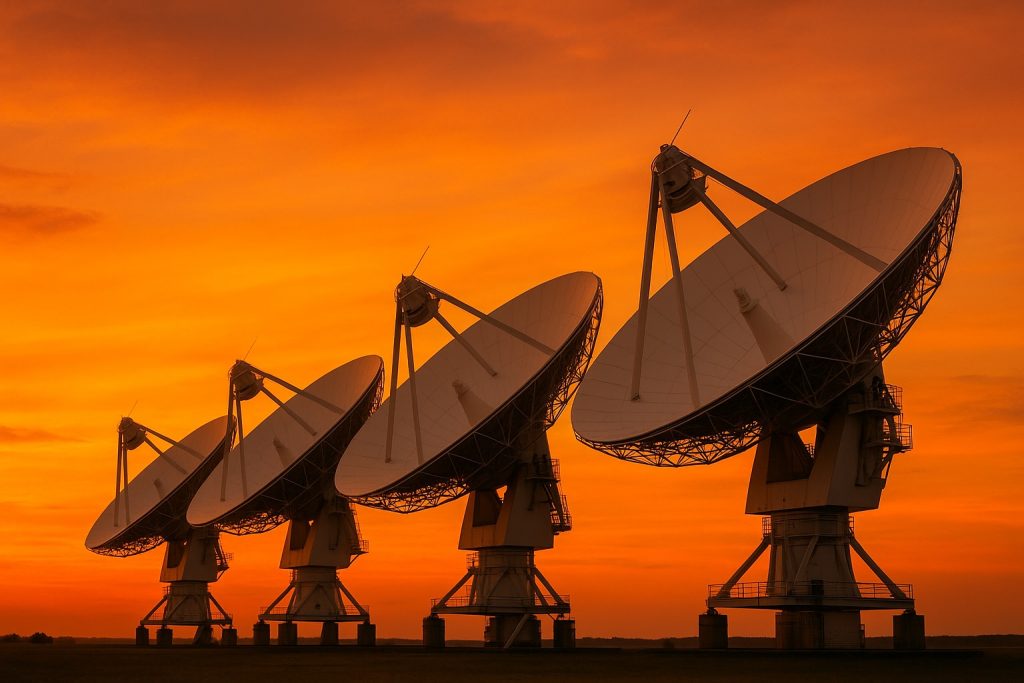- The global space economy was valued at around $630 billion in 2023 and is projected to reach $1.8 trillion by 2035.
- SpaceX revolutionized orbital launch with reusable Falcon 9 and Falcon Heavy rockets and operates the Starlink broadband satellite constellation.
- OneWeb has deployed a Low Earth Orbit broadband constellation of about 648 small satellites for global connectivity.
- Intuitive Machines is developing the Nova-C lunar lander to deliver payloads to the Moon under NASA’s CLPS program.
- Astrobotic is developing the Peregrine and Griffin lunar landers to carry payloads under NASA’s CLPS program.
- Axiom Space is building the first commercial modules for the International Space Station and plans to detach to form Axiom Station, with Ax-1 in 2022.
- Reaction Engines is developing the SABRE engine for the Skylon spaceplane, enabling potential single-stage-to-orbit via an ultra-rapid precooler that cools incoming air from 1000°C to -150°C in milliseconds.
- Capella Space operates a growing constellation of small SAR satellites that provide near-real-time radar images day or night, through clouds, for defense, disaster, and infrastructure monitoring.
- ispace’s Series 1 lander (Hakuto-R) attempted a Moon landing in 2023, pursuing lunar transportation, resource prospecting, and eventual mining services.
- Virgin Galactic began commercial suborbital space tourism with SpaceShipTwo, offering flights to about 80–90 km altitude for a few minutes of weightlessness.
The global space economy was valued at around $630 billion in 2023 and is projected to reach $1.8 trillion by 2035 [1]. Driving this growth are pioneering companies from across the world, building rockets, deploying satellites, and delivering new services from orbit. Below we highlight 100 of the most important space and satellite companies worldwide – spanning launch providers, satellite manufacturers, telecommunications giants, Earth observation firms, in-orbit servicing startups, and more. These game-changing companies are pushing the boundaries of technology and shaping our future in space.
Launch Service Providers (Rockets & Spacecraft Launchers)
These companies develop and operate rockets to carry satellites and spacecraft to orbit, lowering the cost of access to space and enabling global launch services.
- SpaceX (United States) – A private aerospace company revolutionizing orbital launch with reusable rockets (Falcon 9, Falcon Heavy) and developing Starship for deep-space missions, also operating the Starlink broadband satellite constellation.
- Blue Origin (United States) – Founded by Jeff Bezos, this company is developing reusable launch vehicles including New Shepard (suborbital tourism) and New Glenn (orbital rocket), with a long-term vision of enabling millions of people to live and work in space.
- United Launch Alliance (ULA) (United States) – A joint venture of Boeing and Lockheed Martin, providing reliable launch services with rockets like Atlas V and Delta IV, and preparing the next-generation Vulcan Centaur vehicle for both government and commercial satellite launches.
- Arianespace (France/Europe) – Europe’s leading launch service provider operating the heavy-lift Ariane 5 (and upcoming Ariane 6) and medium-lift Soyuz and Vega rockets, launching satellites for commercial and institutional customers worldwide.
- Roscosmos (Russia) – The Russian state corporation for space activities, overseeing the nation’s launch vehicles (Soyuz, Proton, Angara) and human spaceflight program. Roscosmos provides launch services and has a legacy of decades in orbit including support of the International Space Station.
- China Aerospace Science & Technology Corporation (CASC) (China) – China’s primary space contractor, building and launching the Long March rocket family and satellites for everything from crewed missions to lunar exploration. CASC is behind China’s rapid launch cadence and ambitious programs like the Tiangong space station.
- Rocket Lab (United States/New Zealand) – An innovative small-launch company known for the Electron rocket, which provides dedicated launches for small satellites. Rocket Lab is also developing the reusable medium-lift Neutron rocket and manufactures satellite components to offer end-to-end space services.
- Relativity Space (United States) – A newcomer pioneering 3D-printed rockets to dramatically simplify manufacturing. Its Terran 1 rocket reached launch attempt stage, and the company is developing the larger fully-reusable Terran R, aiming to reduce cost and lead times for launches.
- Firefly Aerospace (United States) – A launch provider developing the Firefly Alpha medium-lift rocket (designed to carry small-to-medium satellites to orbit) and working on a lunar lander (Blue Ghost) for NASA missions. Firefly focuses on serving both commercial and government markets for flexible access to space.
- Mitsubishi Heavy Industries (MHI) (Japan) – A Japanese conglomerate that provides Japan’s primary launch services. MHI manufactured and launched the H-IIA rocket fleet and is developing the new H3 launch vehicle, supporting missions for JAXA (Japan’s space agency) and commercial satellite launches in the Asia-Pacific region.
- Isar Aerospace (Germany) – A European startup building the Spectrum small orbital launcher to offer affordable, dedicated launches for small satellites. Based in Germany, Isar is part of Europe’s new wave of privately-developed rockets aiming to increase access to space for smallsat constellations.
- Orbex (United Kingdom) – A UK-based launch company developing the Orbex Prime microlauncher, a lightweight orbital rocket designed to use a renewable bio-propane fuel. Orbex plans to launch from Scotland, providing Europe with a domestic option for launching small satellites.
- Rocket Factory Augsburg (RFA) (Germany) – A German NewSpace startup developing the RFA One rocket, a low-cost launch vehicle capable of delivering small payloads to orbit. RFA emphasizes high-performance engines and staged combustion technology, aiming to offer frequent and affordable launch services from Europe.
- Skyroot Aerospace (India) – A leading Indian private launch startup that successfully flight-tested Vikram rockets. Skyroot is developing a series of indigenous small launch vehicles (named Vikram I, II, III) to serve the growing small satellite market, marking India’s entry into commercial private launch services.
- Agnikul Cosmos (India) – An Indian space startup building the Agnibaan small launch vehicle. Agnikul’s rockets feature a highly modular design and 3D-printed engines, aiming to provide on-demand launches for small satellites from a domestic spaceport and make India a hub for low-cost launch.
- Galactic Energy (China) – A private Chinese launch company that has successfully reached orbit with its Ceres-1 solid-fueled rocket. Galactic Energy is also developing the larger Pallas-1 liquid-fueled rocket, becoming one of China’s most promising commercial launch providers with multiple missions already flown.
- LandSpace (China) – One of China’s first private space launch firms, known for developing the Zhuque-2 rocket, which in 2023 became the world’s first methane-fueled orbital launch attempt. LandSpace is a trailblazer in Chinese commercial rocketry, working to achieve reusable and cost-efficient launch capabilities.
- iSpace (Interstellar Glory) (China) – A Chinese startup that made history as the first private Chinese company to place a satellite in orbit (with its Hyperbola-1 rocket in 2019). iSpace is now developing the Hyperbola-2 reusable methane rocket, aiming to continue innovating in China’s burgeoning private launch sector.
- Astra (United States) – A U.S. company focused on ultra-small, high-frequency launch services with a goal of daily launches. Astra’s Rocket 3 reached orbit in 2021, and the company is iterating on new launch system designs to provide rapid, low-cost delivery of small satellites to orbit.
- Skyrora (United Kingdom) – A British launch startup developing a family of small orbital rockets (like Skyrora XL) and testing proprietary eco-friendly fuel. Skyrora aims to revive sovereign launch capability for the UK, planning to operate from new spaceports in Scotland for small satellite missions.
- PLD Space (Spain) – A Spanish company developing Miura-1 (suborbital) and Miura-5 (orbital) reusable rockets to serve the European smallsat market. In 2023 PLD Space achieved a successful suborbital flight of Miura-1, marking Europe’s first private rocket launch and paving the way for orbital missions.
- SpinLaunch (United States) – A company pursuing a novel launch concept using a kinetic orbital accelerator. SpinLaunch is developing a system to spin and catapult payloads to the edge of space at high speeds, dramatically reducing the need for rocket fuel and potentially offering a low-cost, environmentally friendly launch alternative.
- Aerojet Rocketdyne (United States) – A legendary rocket engine manufacturer (now part of L3Harris Technologies) that produces propulsion systems for many rockets and spacecraft. Aerojet’s engines power vehicles like NASA’s SLS and previously the Space Shuttle’s main engines, making it a crucial supplier of rocket and spacecraft propulsion.
Satellite Manufacturers & Space Systems
These companies build satellites, spacecraft, and space hardware – from communications and GPS satellites to exploration probes and space station modules.
- Boeing (United States) – An aerospace giant that produces advanced satellites and spacecraft. Boeing’s satellite portfolio includes communications satellites (e.g. the 702 platform), military satellites, and the CST-100 Starliner crew capsule. Boeing has contributed to the ISS and is a major NASA contractor for space vehicles.
- Lockheed Martin (United States) – A leading defense and space contractor building numerous satellites and deep-space probes. Lockheed manufactures GPS satellites, military communications and surveillance satellites, and built the Orion crew spacecraft for NASA’s Artemis program, playing a key role in both national security and civil space missions.
- Northrop Grumman (United States) – A major aerospace corporation involved in launch and satellite manufacturing. Northrop builds satellites (including weather and defense satellites), developed the Cygnus spacecraft for ISS cargo resupply, and produces space hardware like the James Webb Space Telescope’s sunshield. It also provides launch vehicles (Pegasus, Antares) and in-orbit servicing through its Mission Extension Vehicles.
- Airbus Defence and Space (Europe) – The space division of Airbus (headquartered in Europe) is a top global spacecraft manufacturer. Airbus builds a wide range of satellites (telecommunications, Earth observation like the Sentinel series, navigation for Galileo), spacecraft (the European Service Module for Orion), and co-manages the Ariane family of launchers – underpinning Europe’s space infrastructure.
- Thales Alenia Space (France/Italy) – A French-Italian joint venture that is a premier manufacturer of satellites and space station modules. Thales Alenia Space supplies communications satellite platforms, builds European navigation and Earth observation satellites, and constructed several modules for the International Space Station, making it a cornerstone of Europe’s space industry.
- OHB SE (Germany) – A German space company known for building small and medium-class satellites. OHB has produced satellites for Europe’s Galileo navigation constellation, Earth observation missions, and scientific projects. The company plays a key role in European space programs, providing innovative space systems and technology services.
- Sierra Space (United States) – A spin-off of Sierra Nevada Corporation focusing on space, Sierra Space develops the Dream Chaser spaceplane (a reusable lifting-body spacecraft for cargo and crew) and is working on inflatable space habitat modules. The company is partnering on the Orbital Reef private space station and aims to enable a commercial space economy in low Earth orbit.
- MDA Ltd. (Canada) – A Canadian space technology company famous for its robotics (it built the Canadarm robotic arms for the Space Shuttle and ISS). MDA also provides satellite systems and Earth observation technology (radar satellites like RADARSAT). With a legacy of innovation, MDA continues to support international space missions and develop next-generation space robotics and sensors.
- Israel Aerospace Industries (IAI) (Israel) – Israel’s leading aerospace and defense company, which builds satellites (including the AMOS communications satellites and reconnaissance satellites like Ofek) and launch vehicles (Shavit small launcher). IAI’s space division has enabled Israel’s independent satellite capabilities and contributes advanced space products globally.
- Surrey Satellite Technology Ltd (SSTL) (United Kingdom) – A pioneer in small satellites, SSTL (now part of Airbus) has designed and built dozens of lightweight, cost-effective satellites for Earth observation, science, and communications. SSTL’s innovations in microsatellite engineering helped kickstart the smallsat revolution, making space more accessible to smaller nations and organizations.
- Ball Aerospace (United States) – An American company that develops spacecraft, satellite instruments, and aerospace components. Ball built iconic space hardware like the Kepler planet-hunting telescope and the optics for the James Webb Space Telescope, and provides satellites and sensors for weather, remote sensing, and national defense. (Official Website: Ball Aerospace at Ball.com)
- Mitsubishi Electric (MELCO) (Japan) – A major Japanese electronics company that is also a leading satellite manufacturer in Japan. Mitsubishi Electric provides satellite buses and builds satellites for communications (it’s behind the Nippon Electric’s DS2000 bus), Earth observation, and meteorology (e.g. the Himawari weather satellites), supporting both domestic programs and commercial customers.
- China Aerospace Science & Industry Corp (CASIC) (China) – A state-owned aerospace company in China that, alongside CASC, develops space technologies. CASIC is known for designing the Kuaizhou solid-fuel small launchers and planning satellite constellations (like the Hongyun broadband network). It produces missiles and spacecraft components, contributing to China’s military and commercial space efforts.
- RSC Energia (Russia) – A historic Russian spacecraft manufacturer (formally S.P. Korolev Rocket and Space Corporation Energia) responsible for legendary programs. Energia designs and builds the Soyuz crew spacecraft and Progress cargo vehicles, modules for space stations (Mir and ISS), and has led human spaceflight development in Russia for decades.
- Terran Orbital (United States) – A growing small satellite manufacturer that specializes in building microsatellites and nanosatellites for government and commercial use. Terran Orbital (parent of Tyvak) is known for its work on CubeSats and is contracted for large constellations (like a planned 300-satellite constellation for Rivada). It partners with major aerospace firms to supply agile space hardware.
- Blue Canyon Technologies (United States) – A company providing high-performance small satellite buses and components. Blue Canyon (a subsidiary of Raytheon) has delivered dozens of small satellites and precision attitude control systems for missions ranging from NASA science spacecraft to commercial constellations, making it a key enabler of the smallsat revolution.
- NanoAvionics (Lithuania) – A Lithuanian company (now part of Kongsberg) that designs and manufactures microsatellite and CubeSat buses. NanoAvionics offers standardized smallsat platforms and end-to-end mission services, allowing companies and research institutions worldwide to get payloads into orbit quickly and cost-effectively.
- Hanwha Aerospace (South Korea) – An emerging aerospace powerhouse from South Korea, Hanwha is investing heavily in space technology including satellite development and rocket engines. Hanwha is involved in Korea’s launch vehicle programs (providing engines for the KSLV-II rocket) and plans to deploy its own LEO satellite constellation, making it a key player in Asia’s growing space industry.
Satellite Communications & Operators
These companies operate satellites or provide satellite-enabled communication services – from global broadband internet to television broadcasting and mobile phone connectivity.
- Intelsat (Luxembourg/United States) – One of the world’s largest and oldest satellite communications companies. Intelsat operates a global fleet of geostationary satellites delivering media broadcast, broadband connectivity, and government communications services across the globe.
- SES (Luxembourg) – A leading international satellite operator based in Luxembourg, SES provides TV distribution, data connectivity, and network services via its extensive fleet (including the Astra satellites for DTH television in Europe and the O3b Medium Earth Orbit constellation for low-latency data).
- Eutelsat (France) – A major European satellite operator with satellites covering Europe, Africa, and Asia. Eutelsat delivers broadcast television, satellite broadband, and corporate networks. It’s now merging with OneWeb to combine geostationary assets with a LEO constellation, reflecting the convergence of satcom technologies.
- Inmarsat (United Kingdom) – A provider of mobile satellite services via its constellation of geostationary satellites. Inmarsat’s network enables global voice and data connectivity for maritime, aviation, and remote land users. (Inmarsat was acquired by Viasat in 2023, expanding Viasat’s reach.)
- Viasat (United States) – A satellite broadband company known for its high-capacity ViaSat satellites that deliver internet service to consumers, in-flight Wi-Fi, and defense communications. After acquiring Inmarsat, Viasat operates a multi-orbit fleet serving both fixed and mobile customers worldwide.
- OneWeb (United Kingdom) – A company deploying a Low Earth Orbit satellite constellation for global broadband internet. OneWeb’s network of ~648 small satellites (nearly fully deployed) delivers low-latency connectivity to enterprises, governments, and remote communities, and the company plans to expand with a second-generation constellation.
- Telesat (Canada) – A Canadian satellite operator providing communications and broadcast services through its fleet of geostationary satellites. Telesat is also developing Lightspeed, a new LEO constellation aimed at delivering enterprise broadband connectivity worldwide, leveraging its long heritage in satellite communications.
- Iridium Communications (United States) – Operator of the Iridium constellation, a network of 66 cross-linked satellites in Low Earth Orbit that enables truly global voice and data coverage (including polar regions). Iridium’s satellite phones and IoT services are critical for maritime, aviation, military, and remote users who need connectivity anywhere on Earth.
- Globalstar (United States) – A satellite operator with a constellation of Low Earth Orbit satellites providing mobile voice and data services, asset tracking, and IoT connectivity. Globalstar is known for its satellite phone services and has recently gained attention through partnerships to enable satellite messaging features in consumer smartphones.
- Thuraya (United Arab Emirates) – A regional mobile satellite services provider based in the UAE. Thuraya operates geostationary satellites covering Europe, Africa, the Middle East, and Asia, offering handheld satellite phones, broadband terminals, and IoT connectivity for users in areas with no terrestrial networks (like deserts or at sea).
- Yahsat (United Arab Emirates) – The UAE’s national satellite operator (Al Yah Satellite Communications) offering a mix of commercial and government communication services. Yahsat’s satellites provide broadband (YahClick), broadcast, and secure military communications across the Middle East, Africa, Europe, and South Asia, supporting connectivity initiatives in those regions.
- China Satcom (China) – China Satellite Communications Co., a state-owned operator managing China’s fleet of communications satellites (the “ChinaSat” series). It provides satellite television, radio, and broadband services across China and also offers capacity to international markets, being a key player in China’s expanding communications infrastructure.
- EchoStar (United States) – A satellite communications company known for its Hughes Network Systems subsidiary (HughesNet satellite internet). EchoStar operates geostationary satellites for broadband internet and video distribution, and is a long-time provider of satellite capacity for DISH Network and international customers.
- Embratel Star One (Brazil) – The largest satellite operator in Latin America, Star One (a subsidiary of Brazil’s Embratel) runs a fleet of communications satellites covering the Americas. Star One’s satellites deliver television broadcast, corporate network, and broadband services, connecting the vast Brazilian and Latin American regions.
- Sky Perfect JSAT (Japan) – Asia’s biggest satellite operator, based in Japan, offering multichannel pay-TV and communication services. SKY Perfect JSAT operates numerous satellites covering Asia-Pacific for broadcasting (platforms like Sky PerfecTV!) and satellite broadband, and is also investing in next-gen satellite networks and space-based data centers.
- Arabsat (Saudi Arabia/Multinational) – A leading satellite operator owned by the Arab League member states and based in Riyadh. Arabsat’s fleet of satellites provides dozens of TV and radio channels, as well as telecommunications and broadband services, across the Middle East, Africa, and parts of Europe, serving over 100 countries.
- AsiaSat (Hong Kong, China) – A prominent satellite operator in the Asia-Pacific region. AsiaSat’s satellites deliver broadcasting, telecom, and connectivity services across Asia, Australia, and the Pacific islands. It provides capacity for TV networks, VSAT networks, and cellular backhaul, helping connect the vast and diverse Asia-Pacific markets.
- Hispasat (Spain) – Spain’s national satellite operator, with a fleet covering Europe and the Americas. Hispasat satellites distribute Spanish and Portuguese-language TV and radio, and provide broadband connectivity solutions in Iberia, Latin America, and North Africa – including programs to bridge the digital divide in rural areas.
- Orbcomm (United States) – An operator of a LEO satellite network dedicated to IoT and machine-to-machine communication. Orbcomm’s satellites and ground infrastructure enable tracking and remote monitoring of transportation fleets, shipping containers, equipment, and environmental sensors worldwide, making it a key enabler of global logistics and asset management.
- AST SpaceMobile (United States) – A company building the first space-based cellular broadband network directly accessible by standard mobile phones. AST SpaceMobile is launching large high-powered satellites (BlueWalker/BlueBird) designed to connect with everyday 4G/5G smartphones on Earth, aiming to eliminate cellular coverage gaps globally from space.
- Spacecom (Israel) – An Israeli satellite operator that owns and operates the AMOS series of communications satellites. Spacecom provides broadcast and broadband services in Europe, the Middle East, Africa, and Asia via its AMOS fleet, and supports data connectivity and DTH television, positioning Israel as a player in the international satcom market.
Earth Observation & Geospatial Analytics
These companies operate satellites that observe Earth or provide geospatial data analytics – supporting applications like mapping, environmental monitoring, and intelligence.
- Planet Labs (United States) – Operator of the world’s largest fleet of Earth imaging satellites, Planet uses swarms of small CubeSats (“Doves”) to capture daily, planetary-scale imagery at medium resolution. Its data – frequently updated imagery of Earth’s landmass – empowers applications from agriculture to disaster response by revealing changes in near real time.
- Maxar Technologies (United States/Canada) – A leader in high-resolution Earth observation and satellite manufacturing. Maxar (formerly DigitalGlobe + MDA) owns the WorldView/GeoEye constellation, providing some of the highest resolution satellite imagery commercially available, and also builds satellites for government and commercial missions – making it integral to both imagery intelligence and spacecraft supply.
- BlackSky (United States) – An geospatial intelligence company operating a fleet of small imaging satellites to provide high-revisit Earth pictures paired with an AI/analytics platform. BlackSky’s satellites can monitor strategic locations multiple times per day, and its software platform delivers alerts and insights to government and commercial customers based on changes detected in imagery.
- Capella Space (United States) – A pioneer in synthetic aperture radar (SAR) imaging with a growing constellation of small satellites. Capella’s satellites can see Earth’s surface day or night and through clouds, providing near-real-time high-resolution radar images for applications like defense surveillance, disaster assessment, and infrastructure monitoring, where optical satellites are limited.
- ICEYE (Finland) – A Finnish company operating a large constellation of microsatellites for SAR imaging. ICEYE’s technology provides frequent, high-quality radar images enabling monitoring of floods, sea ice, oil spills, and illicit activities regardless of weather or lighting. It has been a key data source for insurance and government agencies, demonstrating the commercial value of SAR data.
- Spire Global (United States) – A space-powered data company with a fleet of nanosatellites in low Earth orbit. Spire’s multi-purpose satellites collect radio occultation data for weather forecasting, track ship traffic via AIS signals, monitor aircraft via ADS-B, and gather other RF data. Spire turns this space-collected data into analytics for maritime, aviation, weather and climate, serving both commercial and government clients.
- Satellogic (Argentina) – A company deploying a constellation of relatively low-cost Earth observation satellites capable of high-resolution multispectral imaging. Originating from Argentina, Satellogic focuses on making geospatial imagery more affordable and accessible, aiming for weekly (and eventually daily) revisits of any point on Earth to support agriculture, forestry, urban planning and more.
- GHGSat (Canada) – A specialized Earth observation company using small satellites to monitor greenhouse gas emissions. GHGSat’s constellation can detect and measure point-source emissions of gases like methane and CO₂ from industrial facilities. This data helps energy companies and regulators track leaks and reduce emissions, highlighting the growing role of private satellites in climate change mitigation.
- Synspective (Japan) – A Tokyo-based startup building a constellation of SAR satellites focused on urban and land monitoring. Synspective’s compact SAR microsatellites provide high-frequency imagery to support smart city planning, disaster response (e.g. flood mapping), and infrastructure management in Japan and around the world, with an eye towards near-real-time solutions.
- EarthDaily Analytics (Canada) – An Earth observation company (formerly UrtheCast) developing the EarthDaily constellation which will capture daily medium-resolution, multi-spectral images of the planet. Alongside the planned satellites, EarthDaily provides analytics-ready geospatial data and services for agriculture, environmental monitoring, and resource management, turning raw imagery into actionable insights.
- Umbra (United States) – A commercial SAR satellite provider with a growing constellation of small high-resolution radar satellites. Umbra’s satellites are designed to produce some of the highest-resolution radar images available (with resolution better than 25 cm), and the company offers an open data access program – aiming to make ultra-fine radar imagery accessible for applications from security to environmental science.
- Kleos Space (Luxembourg) – A company flying clusters of small satellites that detect and geolocate radio frequency signals on Earth’s surface. Kleos’s RF reconnaissance data can identify maritime activity by picking up ship communications, even when vessels try to hide (going “dark”). This space-derived intelligence is used for border security, maritime domain awareness, and anti-piracy/trafficking operations.
- Chang Guang Satellite Technology (CGSTL) (China) – A Chinese commercial satellite developer and operator behind the Jilin-1 Earth observation constellation. CGSTL’s growing fleet of high-resolution optical and video imaging satellites provides imagery for both government and commercial clients, supporting urban planning, agriculture, and disaster relief in China and beyond. It represents China’s push into commercial remote sensing.
- Pixxel (India) – An Indian space startup launching a constellation of hyperspectral imaging satellites. Pixxel’s satellites capture imagery in dozens of spectral bands, allowing detailed analysis of Earth’s chemistry for use cases like crop health monitoring, pollution detection, and mineral exploration. Pixxel aims to provide a global hyperspectral dataset that can help predict and manage environmental challenges.
- Dragonfly Aerospace (South Africa) – A company based in South Africa building high-performance imaging satellites and payloads. Formed by veteran engineers, Dragonfly offers advanced optical cameras and designs small and medium Earth observation satellites. By continuing South Africa’s heritage in space imaging (from the SunSat and EOSat era), Dragonfly is putting African space tech on the map and supplying global customers with EO solutions.
In-Orbit Servicing & Space Infrastructure
These companies are developing capabilities to service, repair, or refuel satellites in orbit, as well as build new infrastructure like private space stations and lunar landers – laying the groundwork for a sustainable space ecosystem.
- Astroscale (Japan) – A trailblazer in on-orbit servicing and space debris removal. Headquartered in Tokyo with international offices, Astroscale is developing missions to safely rendezvous with and remove defunct satellites and rocket upper stages from orbit. Its technology (like the ELSA-d demo spacecraft) aims to tackle space junk and extend satellite lifespans by servicing them, making space operations more sustainable.
- ClearSpace (Switzerland) – A Swiss startup contracted by ESA for the world’s first active debris removal mission (ClearSpace-1). ClearSpace is building a spacecraft with four robotic arms to capture a spent Vega rocket adapter in 2026 and deorbit it. The company’s longer-term goal is to provide “space cleanup” services and in-orbit servicing, addressing the urgent need for space traffic management.
- D-Orbit (Italy) – An in-space logistics and transportation company based in Italy. D-Orbit’s ION Satellite Carrier is an orbital transfer vehicle that carries multiple small satellites as payload, deploys them to custom orbits, and can perform technology demonstrations. By offering last-mile delivery in space and eventually debris removal, D-Orbit is simplifying launch integration and enabling more flexible deployment of satellite constellations.
- Momentus (United States) – A company providing orbital transfer and tug services with its Vigoride spacecraft. Momentus’s vision is to ferry satellites from the drop-off point of the launch rocket to their precise operational orbits and even between orbits, using water plasma propulsion. Despite early regulatory and technical challenges, Momentus is among the first movers in the in-space transportation market, aiming to make satellite deployment more versatile.
- Orbit Fab (United States) – Billing itself as “Gas Stations in Space,” Orbit Fab is developing in-orbit refueling technology for satellites. It has created a standard refueling port (RAFTI) for satellites and launched prototype fuel tankers to orbit. By enabling spacecraft to refuel on-orbit rather than be limited by their initial fuel load, Orbit Fab seeks to extend satellite lifetimes and jumpstart a resupply infrastructure in space.
- Axiom Space (United States) – A Houston-based company building the first commercial modules for the International Space Station and a future private space station. Axiom will attach its habitable modules to the ISS, intending to detach and form “Axiom Station” when the ISS retires. The company also manages private astronaut missions to the ISS (such as Ax-1 in 2022), with the goal of becoming a full-service orbital destination for research and tourism in low Earth orbit.
- Nanoracks (United States) – A company that pioneered commercial utilization of the ISS by flying privately funded experiments and small satellites from the station. Nanoracks provides services like satellite deployments (via its CubeSat deployers) and operates the Bishop Airlock on the ISS. In partnership with Voyager Space and Lockheed Martin, Nanoracks is also leading the development of Starlab, a free-flying commercial space station set to launch later this decade.
- Voyager Space (United States) – An innovative space holding company that acquires and supports a portfolio of space enterprises. Voyager’s subsidiaries include Nanoracks, space robotics firms, and more – collectively working on projects like the Starlab space station and advanced robotics. Voyager’s model is to create a vertically integrated NewSpace ecosystem under one umbrella, accelerating the development of commercial space infrastructure and exploration capabilities.
- Redwire (United States) – A space infrastructure company formed by merging several innovative firms (Adcole, Deep Space Systems, Made In Space, etc.). Redwire offers a broad range of technologies: from in-space manufacturing (it operates 3D printers on the ISS) to deployable structures, solar arrays, and navigation avionics. Redwire’s products have flown on missions to the Moon and Mars, and the company is enabling new capabilities like on-orbit construction and sustainable habitats that will support long-duration missions.
- Astrobotic (United States) – A company focused on lunar delivery and robotics. Astrobotic is developing a series of lunar landers (e.g. Peregrine and Griffin) to carry payloads to the Moon’s surface under NASA’s Commercial Lunar Payload Services (CLPS) program. It is also working on lunar rovers (like the small CubeRover and larger Polaris rover). By providing commercial lunar transportation and exploration services, Astrobotic is helping return humanity to the Moon and jumpstarting the cis-lunar economy.
- Intuitive Machines (United States) – Another key player in commercial lunar exploration, Intuitive Machines is building the Nova-C lunar lander to deliver payloads to the Moon (also under NASA’s CLPS program). Its lander is slated to land at various lunar sites carrying scientific instruments and rover deployers. Intuitive Machines additionally works on lunar data relay satellites and other tech, with the broader aim of providing frequent, low-cost access to the lunar surface for science and industry.
- ispace (Japan) – A private Japanese company that has set its sights on developing a lunar economy. ispace’s Series 1 lander (part of its Hakuto-R program) attempted a Moon landing in 2023, coming very close to success, and the company is refining its lander for future missions. It envisions providing transportation, resource prospecting (like mapping lunar water ice), and eventually mining services on the Moon. ispace Japan, along with its subsidiaries in Europe and the US, represents one of the first generation of commercial lunar enterprises.
- Impulse Space (United States) – A newer startup focusing on in-space mobility and ambitious exploration missions. Founded by former SpaceX engineers, Impulse is developing orbital transfer vehicles to reposition satellites and deploy constellations. Notably, Impulse Space announced a partnership with Relativity Space for a private mission to Mars, providing the Mars cruise vehicle and lander for a future mission. By combining bold vision with practical orbital service tech, Impulse aims to greatly extend commercial activity from Earth orbit to deep space.
Space Exploration, Tourism & Other Pioneers
This category features companies breaking new ground in human spaceflight, space tourism, resource extraction, and other frontier endeavors that fall outside traditional satellite operations.
- Virgin Galactic (United States) – A space tourism company founded by Sir Richard Branson, offering suborbital flights for private individuals. Virgin Galactic’s SpaceShipTwo is a winged spaceplane that is air-launched from a carrier aircraft; it carries passengers to the edge of space (about 80–90 km altitude) for a few minutes of weightlessness and Earth views. The company has already flown its founder and is commencing commercial operations, making suborbital space accessible to civilian astronauts (at a hefty price).
- Space Adventures (United States) – A private spaceflight experience company that brokered trips for the world’s first space tourists. In partnership with Roscosmos, Space Adventures sent seven paying clients (like Dennis Tito and Cirque du Soleil’s Guy Laliberté) to the International Space Station aboard Soyuz spacecraft in the 2000s. They continue to offer orbital spaceflight opportunities (including future circumlunar flights around the Moon) and zero-gravity jet flights, serving as a key intermediary making once-impossible adventures a reality for ultra-wealthy customers.
- NewSpace India Limited (NSIL) (India) – The commercial arm of the Indian Space Research Organisation (ISRO), NSIL handles the marketing of India’s launch vehicles and satellites to international customers. Incorporated in 2019, NSIL is responsible for commercial launches of the PSLV and GSLV rockets, satellite rideshare opportunities, and commercialization of Indian space-based services. It embodies India’s push to engage with the global space market by leveraging ISRO’s capabilities for commercial contracts and partnerships.
- Reaction Engines (United Kingdom) – A company known for developing the revolutionary SABRE engine – an air-breathing rocket engine intended to power the proposed Skylon spaceplane. SABRE can operate as a jet at low altitudes and as a rocket in space, thanks to a proprietary ultra-rapid precooler that cools incoming air from 1000°C to −150°C in milliseconds. This technology could enable single-stage-to-orbit vehicles and hypersonic flight. Reaction Engines has faced recent financial challenges, but its decades of R&D in propulsion have pushed the envelope in high-speed air-breathing engine design.
- Space Perspective (United States) – A startup taking a gentler approach to space tourism by using high-altitude balloons. Space Perspective is developing the Neptune capsule, a pressurized lounge that will be lifted to ~30 km altitude by a giant hydrogen balloon. Passengers will spend about two hours at the peak floating in the stratosphere, observing the curvature of Earth against the blackness of space. While not reaching space by definition, it promises an accessible and smooth “edge of space” experience by 2024–2025 at a lower price point than rocket-based tourism.
- AstroForge (United States) – A forward-looking startup with the audacious goal of mining asteroids for valuable resources. AstroForge is developing technology to extract metals from small near-Earth asteroids – essentially moving the mining and refining process off-planet. In 2023, AstroForge launched a test payload to validate its refining tech in space, and it plans a future mission to rendezvous with an asteroid. If successful, AstroForge could open the door to harvesting rare materials from space, potentially revolutionizing resource supply on Earth and supporting in-space manufacturing.
- Bigelow Aerospace (United States) – Known for its work on inflatable space habitats, Bigelow developed the BEAM (Bigelow Expandable Activity Module) that has been attached to the ISS since 2016 as a technology demonstrator. The company envisioned creating standalone private space stations using large expandable modules (BA-330). While Bigelow Aerospace is currently in a dormant state (having laid off most staff in 2020), its innovations demonstrated the viability of inflatable structures in space – a concept likely to re-emerge in future commercial space stations due to the volume and mass advantages.
- Bellatrix Aerospace (India) – An Indian startup working on next-generation propulsion and orbital transportation. Bellatrix is developing electric propulsion systems (like Hall thrusters) and even a small “space taxi” orbital transfer vehicle called Orbital Transfer Vehicle (OTV) to move satellites between orbits. It has also proposed a unique microsatellite launch vehicle. Bellatrix’s propulsion tech could enhance satellite missions through efficient maneuvering, and its ambitious plans reflect the growing vibrancy of India’s private space sector.
- LeoLabs (United States) – A company focused on tracking objects in Low Earth Orbit using ground-based radars. LeoLabs operates a global network of phased-array radars (in locations like the US, New Zealand, Costa Rica, and the Azores) to monitor satellites and debris as small as 2 cm. Through its cloud-based platform, LeoLabs provides satellite operators and regulators with real-time data on orbital positions and collision warnings. As space gets more crowded, LeoLabs’ services are pivotal for space situational awareness and preventing accidents in orbit.
- The Exploration Company (Europe) – A European startup (based in France and Germany) developing “Nyx”, a reusable orbital spacecraft aimed at carrying cargo – and eventually crew – to destinations like space stations or even the Moon. Founded in 2021, the company is taking a modular approach to space vehicles, planning an initial demonstration of a small capsule in orbit in the mid-2020s. The Exploration Company’s vision is to provide affordable, independent European access to orbital and lunar missions for both public and private customers, symbolizing a new wave of European NewSpace entrepreneurship.
Each of these 100 companies plays a unique role in the expanding space economy. Together, they span the full spectrum of space activities – launching rockets, manufacturing satellites, connecting the world via spacecraft, imaging our planet, building infrastructure in orbit and beyond, and even taking the first steps to mine asteroids and send tourists to space. These organizations across the globe are truly shaping our future in orbit, turning once science-fictional ideas into reality and ensuring that space remains a dynamic frontier of innovation and opportunity. [2] [3]
References
1. smartbranding.com, 2. smartbranding.com, 3. smartbranding.com










